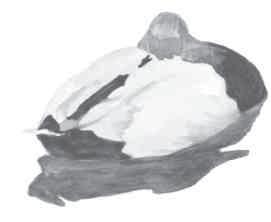
3 minute read
Unusual Pochard behaviour..................................................David Cawdron
largely in Greenland and Iceland. A much smaller population wintering in the low-countries originates in Svalbard (Holt, C.A. et al2011). Due to Landguard’ s position, while it is possible that some records may originate from the Svalbard population, the bulk of birds are presumed to have come from the Icelandic and Greenland populations. It is predicted that Landguard will receive more records over time if the population of Pink-footed Geese continues to increase at its current rate, or if population pressure in Norfolk forces flocks further south to winter in Suffolk.
Acknowledgement: Many thanks to Steve Goddard for comments on drafts of this note. References: C.A. Holt, G.E. Austin, N.A. Calbrade, H.J. Mellan, C. Mitchell, D.A Stroud, S.R. Wotton, & A.J. Musgrove ‘Waterbirds in the UK 2009/ 2010: The Wetland Bird Survey ’2011 BTO/RSPB/JNCC, Thetford. G. Lowe, ed. 2002 SuffolkBirds. Vol. 50. Suffolk Naturalists ’ Society, Ipswich. N. Mason ed. 2011 SuffolkBirds 2010. Vol. 60. Suffolk Naturalists ’ Society, Ipswich. D.R. Moore, ed. 1981 SuffolkBirds 1980. Suffolk Naturalists ’ Society, Ipswich. S.H.Piotrowski ed. 1991 SuffolkBirds 1991. Vol.40. Suffolk Naturalists ’ Society, Ipswich. S.H. Piotrowski, 2003 The Birds ofSuffolk. Christopher Helm, London. Nigel Odin, Landguard Bird Observatory, View Point, Felixstowe, Suffolk, IP11 3TW E.mail: landguardbo@yahoo.co.uk
David Cawdron
Unusual Pochard breeding behaviour
The moment I knew that I had found something very unusual was when I viewed the nest from a different position and saw that it had been lined with feathers.
I first found the nest on 11th May 2009 when two Great Crested Grebe at a Breckland site in Suffolk occupied it. It was a typical Great Crested Grebe ’ s nest built of vegetation and attached to the base of a tree standing in water. On my next visit on 19th May, both adults were away from the nest and one of the adults had two small young sitting on its back. However, when I checked the nest site that I’d previously found to see whether these birds had used that nest, I found a female Pochard1 sitting very low in it, only just visible above the top of the nest. On four subsequent visits, the female remained sitting on the nest, until 20th June when a female and two small young were found near the nest, which was now unoccupied.
Unusualnesting behaviour Pochards are rare breeding birds
2 . I viewed the nest from a distance during the nesting period and subsequently completed a partial BTO nest record. The nest contents were not examined and so it is not possible to say how many eggs were present at any given time or precisely what the overall productivity of the nest was. That said, after leaving the nest, the young continued to grow and were found to be fully grown on 29th July. The female and two juveniles were last seen at this site in early August. In 2011, I found a female Pochard making a breeding attempt at the same site in similar circumstances. This time a recently vacated Coot’ s nest was used. This nest had originally been made in the branches of a tree at water level on a small island and was partially hidden. A female Pochard was seen sitting on the nest on 1st June and, as in the previous case, was sitting very low in it and was only just visible above the nest’ s top. However, on 9th June the nest appeared to be unoccupied and by 15th June had been destroyed. As in 2009, the nest
1 Pochards have bred in Breckland sites in Suffolk since the 1950’ s but have declined in recent years. In 2009 broods were located at three Breckland sites, while in 2010 at just one. 2 The BB's 2010 Rare Breeding Bird report states that the UK five-year mean was 632 pairs.








